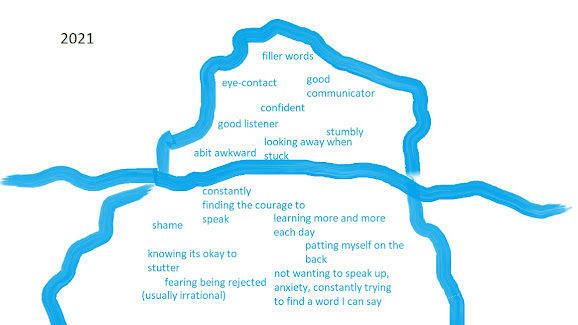The iceberg anology
I could sit here and talk about Freud’s theories all day, after having done four years using and debating his theories, but now is not the time for that. Now, is the time to delve into Joseph Sheehan’s theory of the iceberg.
Sheehan was a clinical researcher and psychologist who used Freud’s
concept of the iceberg for stuttering. Sheehan believed that stuttering was
often more disruptive to a person's emotional well-being than it was to their
speech, implying that stuttering can play a significant role in a person's mental
health.
‘Stuttering is like an iceberg, with only a small part above the waterline and a much bigger part below’. – Joseph Sheehan, Stuttering: Research and Therapy (1970)
Essentially, stuttering is only the tip of the iceberg, the visible part of the iceberg, but the part beneath the surface, the emotional baggage that a person who stutters carries because of their stutter, 'the unseen pain', is the most damaging to the person who stutters. And I believe that with each rebuke, with each cruel word or action directed at a stutterer, the part of the iceberg beneath the surface grows bigger and more negative and the person who stutters succumbs to the invisible pain that he or she feels, inevitably losing all faith in themselves and the world around them.
In relation to my experience with the iceberg analogy, speech
therapists have provided the majority of my iceberg knowledge. In my therapy
sessions, I used to have to draw icebergs and then fill in the blanks with the
behaviours that people could see, as well as the feelings they couldn't. My
icebergs have obviously changed over time, and as I learn to accept and become
friends with my stutter, the part under the water appears to change with each
passing year.
My current relationship with my stutter is largely one of acceptance
and care. I still have my days where my stuttering really gets to me, for
example when I can’t gather the energy to order a coffee so I get my friend to
do it, which inevitably makes me feel ashamed that I couldn’t behave like a
fluent person and that I’m not good enough. But I also have my days where I live
my life wholeheartedly, I feel confident in myself and I feel I am just like
everyone else. I believe that people think I’m a confident person, if a little
awkward sometimes whose words stumble sometimes when she talks.
Icebergs are useful to use when you want to assess where you are with your
stutter and how you see yourself as a person who stutters. And even for someone
who doesn’t stutter, the iceberg is useful in order for you to assess the
relationship you have with yourself compared to the world around you.
To end on a positive note, the iceberg beneath the surface
can show all your negative feelings but can also represent the immense amount
of strength you have yet to discover about yourself.





Comments
Post a Comment